Pencil grip & hand dominance development
The five pencil grip developmental stages
Every child is different, developing the skills needed to hold a pencil at a different time to their peers.
There are 5 developmental stages, that a child needs to go through, before they can successfully use a mature tripod grip. They need to work through each stage and as their hand, shoulder and arm strength and mobility increases so does the ability to move to the next developmental stage of the grip.
There are principles of development called “big to small” and “proximal to distal” – basically this means that children develop the larger muscles of the trunk and arms before the smaller muscles of the hands and that the proximal muscles closer to the body centre (shoulder muscles, upper arm muscles) develop before the distal muscles which are further away (hand muscles).
If a toddler is taught how to hold a pencil using the tripod grip before they are physically ready, they are inclined to develop a poor pencil grip which is difficult to change once they are older. These grips can make handwriting difficult and less fluid as well as making writing a very tiring task. It can also turn some children off colouring, drawing and handwriting as they are not pleasurable experiences.
A child may not develop a three finger tripod pencil grip until the age of 5/6. This is considered the most appropriate pencil grip, for right and left-handed writers, as it allows the fingers and wrist to work together to provide a more free flowing movement.
Stage 1 - Palmer-supinate grasp
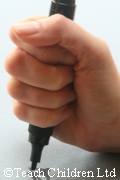
Holds the crayon/pencil in fist (whole hand) like a dagger. They use whole arm movements from the shoulder to mark-make. Due to this whole arm movement they prefer to work on a vertical surface.
Stage 2 - Palmer or digital-pronate grasp
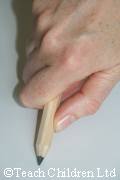
Holds a crayon/pencil with the palm of the hand facing down towards the paper. The crayon/pencil is held by all the fingers and the thumb. The movement comes from the shoulder and elbow. Again due to the way the arm moves a vertical surface is preferred.
Stage 3 - Four finger and thumb grip
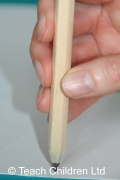
Holding the crayon/pencil between the thumb and four fingers with the crayon/pencil in a nearly vertical, upright position. Movement comes from the elbow and wrist.
Stage 4 - Static quadruped or tripod grip
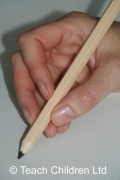
Holding the pencil in very nearly in the correct position however the web space is narrower than it would be if held in a mature tripod grip. This means that the movement is coming from the wrist and large finger movements.
Stage 5 - Mature / Dynamic tripod grip
Right-
Handed
Left-
Handed
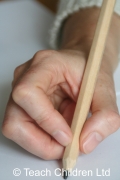
This is traditionally considered the most appropriate handwriting pencil grip for both left and right-handed writers. Holding the pencil between the thumb and index finger with pencil supported on the middle finger. The ring and little fingers are gently curled inwards. This gives an open wide web space which means the movement comes from the fingers.
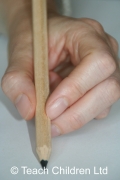
Hand dominance
What is hand dominance?
Hand dominance is where one hand has more influence or control than the other. This is sometimes referred to as hand preference, where one hand is preferred or chosen over the other, as it is more reliable in performing a range of skilled activities (handedness).
Children tend to develop hand dominance between the ages of 3-5 years old, for some it may be slightly later and for a few it does not become a subconscious decision until they are 8 or 9 years old. Many children will naturally develop a clear right or left hand dominance which is greatly influenced by their genetics.
Some can develop a mixed dominance, this is where a child finds they have more control and greater skills for handwriting with say the left hand but prefer and display more precise skills with the right hand in tasks such as using scissors. Studies have shown handedness can be based on the type of muscles used in controlling gross and fine motor skills for completing particular tasks. The control of various muscle types is located in different hemispheres of the brain. Those relating to dexterity (fine motor skills), required for writing, are strongly related to hand dominance, whereas the larger muscle groups (gross motor skills), involving strength, rely less on hand dominance.
Only about 1% of the population are truly ambidextrous, which means they are able to perform tasks using either hand with equal skill and proficiency; a rare trait indeed.
Whether a child is right or left-handed does not affect their academic ability or progress, if they have developed and been taught the appropriate key skills. The important thing is not to force particular hand dominance on a child. It will never feel natural for them and the acquisition of gross and fine motor skills will feel awkward and may well appear clumsy, delaying their development, skills ability, confidence and self-esteem.


Developmental stages of hand dominance
- During the first year:
- A baby will start to use one hand then the other.
- From about 4 mths old they will begin to move both hands together, this is called Symmetrical Movement (clapping and jumping).
- At about 1 yrs old one hand assists another.
- Years 3-5
- A child begins to use one hand to stabilise an object, while the other acts upon it, but not consistent in hand roles.
- A child may use the left hand to pick up or do activities that are on the left hand side of the body and then swap to use the right hand for those on the right.
- A child begins to prefer to use one hand to the other when tackling tasks most of the time.
- Particular hand dominance is usually developed by the time they are school age, but not in all cases so don’t worry it is not unusual.
The mature stage of development in hand dominance is to establish at least one hand for skilled work and for both hands to work together in a complementary way so that a variety of tasks can be accomplished effectively.
How handedness develops
A child develops handedness as their body awareness and movement skills (gross and fine motor skills) increase over time.
There are three main stages of development each child needs to experience and develop through:
1. Symmetrical Movement (Both hands and feet move together)
Clapping - Jumping - Double hand grasping (seen in babies and toddlers)
2. Reciprocal Movement (both sides of the body work together)
Crawling - Walking - Running - Climbing
Crawling has a very important role in a child’s development as it develops good bilateral coordination in preparation for handedness.
3. Asymmetrical Bilateral Coordination (both sides of the body work together doing different things)
Kicking a ball - Using scissors - Open a jar - Threading - Playing a musical instrument
As a child starts to use both hands in this way the ability to cross the mid-line (taking one part of the body, for example the left hand, across an imaginary line that runs vertically down the body through the middle of the chest and belly button to the right side of the body and vice versa) begins to emerge. It is important that a child can cross the mid-line as a comfortable and spontaneous action to ensure that the dominate hand gets the practice, and experiences a range of tasks, if hand dominance is to develop to the mature stage.

